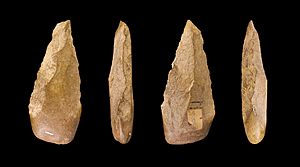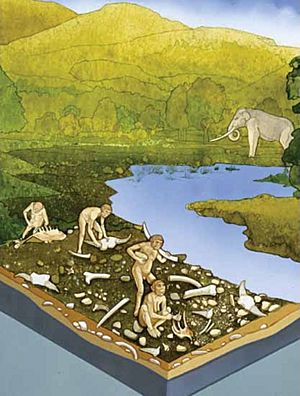Lower Paleolithic facts for kids
| The Paleolithic |
|---|
|
↑ Pliocene (before Homo) |
| Lower Paleolithic (c. 3.3 Ma – 300 ka)
(300–45 ka)
(50–10 ka)
|
| ↓ Mesolithic ↓ Stone Age |
The Lower Paleolithic is the earliest part of the Old Stone Age. It started about 3 million years ago when the first signs of stone tools made by early humans appeared. This period lasted until about 300,000 years ago. During this time, two main types of stone tools were made: the Oldowan (called "Mode 1") and the Acheulean (called "Mode 2").
In Africa, this time is known as the Early Stone Age. The very first tools found, from a place called Lomekwi, are about 3.3 million years old. The "Mode 1" tools began around 2.6 million years ago. The "Mode 2" tools ended between 400,000 and 250,000 years ago.
After the Lower Paleolithic came the Middle Paleolithic. In this later period, people started making more advanced tools using a method called the prepared-core technique. Scientists are still trying to figure out if early humans learned to control fire during the Lower or Middle Paleolithic.
Contents
First Tools and Early Humans
The Lower Paleolithic began with the invention of the first stone tools. For a long time, people thought these tools were made by Homo habilis, a type of early human, about 2.8 million years ago. However, new discoveries have changed this idea.
The Oldowan tools, which were thought to be the oldest, are now believed to have started around 2.6 million years ago. These tools might have been used by even earlier human relatives called australopithecines, like Australopithecus garhi.
Even older tools were found in 2015 at a place called Lomekwi 3 in Kenya. These tools are about 3.3 million years old! This means they were made even before the time period known as the Pleistocene.
The early members of the Homo group, like Homo habilis, made simple Oldowan tools. These tools were common for almost a million years, from about 2.5 to 1.7 million years ago. Homo habilis likely survived by scavenging. They used their tools to cut meat from dead animals or to break bones to get the marrow inside.
Life changed a lot for these early humans. Their ancestors, the australopithecines, mostly ate fruits and plants. But as the climate in East Africa became drier, forests turned into savannah grasslands. This meant less fruit was available. So, early humans started looking for new food sources in the drier savannah, like meat from scavenging. This change in diet also led to better ways of communicating. Early humans needed to "recruit" or gather their group members to help scavenge large animal carcasses.
Around 1.8 million years ago, a new type of human appeared: Homo erectus. This happened through an earlier form called Homo ergaster.
Hunting and Migration
Homo erectus changed from just scavenging to actively hunting animals. They developed a hunting-gathering way of life. This lifestyle became very important and lasted throughout the Paleolithic and into the Mesolithic period.
This new way of finding food led to many other changes in how humans behaved and even in their bodies. This eventually led to the appearance of Homo heidelbergensis about 600,000 years ago.
Homo erectus also began to move out of Africa and spread across Asia and Europe. Stone tools found in Malaysia are 1.83 million years old. The famous Peking Man fossil, found in China, is about 700,000 years old.
In Europe, the Oldowan tool tradition (also called Abbevillian there) split into two types:
- The Clactonian, which focused on making tools from flakes of stone.
- The Acheulean, which was known for making hand-axes.
During this time, a new way of shaping flint, called the Levallois technique, also developed.
Homo erectus was likely the human type that moved from Africa to Europe. They are linked to the flake tool tradition that spread across southern Europe and into southeast Asia. Many tools from the Middle Paleolithic were made using the Levallois technique. This suggests that Neanderthals might have evolved from Homo erectus or Homo heidelbergensis.
At Monte Poggiolo in Italy, archaeologists found an Acheulean handaxe workshop dating from 1.8 to 1.1 million years ago.
Later Lower Paleolithic Humans
- Further information: Homo heidelbergensis,, and Archaic humans
About 600,000 years ago, Homo heidelbergensis appeared. This led to other new types of humans, like Homo rhodesiensis and Homo cepranensis, around 400,000 years ago.
Homo heidelbergensis is considered a possible candidate for developing an early form of symbolic language. Scientists are still debating if early humans controlled fire or started burying their dead during this period, or if these practices appeared later in the Middle Paleolithic.
In Europe, a type of human that was in between Homo erectus and Homo sapiens also appeared. These are sometimes called archaic Homo sapiens. Fossils from places like Swanscombe and Steinheim are examples. The hand-axe tradition also started around this time. Homo heidelbergensis is thought to be responsible for making better Mode 2 Acheulean tools in Africa after 600,000 years ago. Both flake tools and hand-axes were used in Europe, sometimes at the same sites. The hand-axe tradition also spread to places like Arabia and India, but it did not reach southeast Asia.
Moving to the Middle Paleolithic
From about 300,000 years ago, tools, social groups, and behaviors became more complex. This included the use of prepared-core techniques for tools, the first signs of burials, and changes in hunting-gathering methods. The first Homo sapiens (humans like us) appeared about 300,000 years ago, with fossils found at Jebel Irhoud in Morocco.
Lower Paleolithic in India
Guy Ellcock Pilgrim, a British geologist, found 1.5 million-year-old teeth and part of a jaw in India. This showed that very old human relatives lived in the Pinjore region near Chandigarh during the Acheulean period. Stone tools made of Quartzite from the Lower Paleolithic have also been found in this area, stretching from Pinjore to Nalagarh.
See also
 In Spanish: Paleolítico inferior para niños
In Spanish: Paleolítico inferior para niños
- Control of fire by early humans
- Lomekwi, the place where the oldest tools were found



